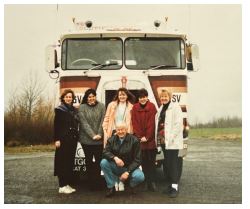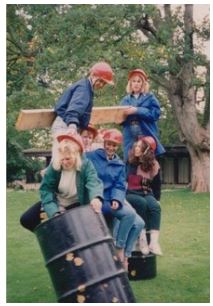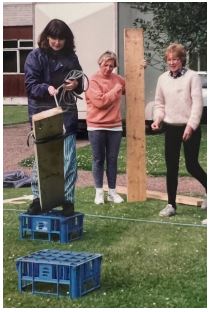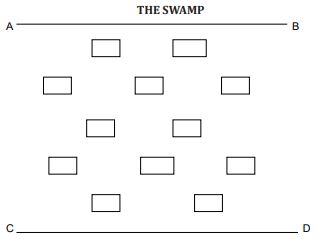The paper traces the transformative journey of a large IT Division in a prominent UK Life Insurance and Pensions Company, following the passing of the Equal Opportunities Act in 1984 and the Equality Act in 2010. Initiatives such as WIMIN (Women Into Management INitiative) were introduced to promote women's representation at the management level. This was done through various training sessions, role model interactions, and leadership development programmes specially designed for women. The emphasis was on helping participants recognize and harness their unique leadership styles. The initiative led to a notable increase in the percentage of women in leadership roles within the IT Division.
This paper also provides the origins of this approach through to the needs of today’s UK needs for RTD (Recruit, Train, Deploy)
The reasons why this approach is effective and reliable is as follows:
- Provides role models to show that equality can be achieved and does exist
- The target audience are given the opportunity to develop their own management style
- Single sex training provides focus and breathing space
- A combination of outdoor challenges linked to Action Learning in the classroom
- Novel reinforcement by role model attendance during the training
Adaption of a proven outdoor motivation training methodology
Keywords: Role models, Single sex, Outdoor challenges, Action Learning, RTD
The Equal Opportunities Act was passed in 1984, followed by the Equality Act in 2010, which triggered the need in a large IT Division to create opportunities for women as well as training to enable them to fulfil equal roles.
In 1992 the IT Division was at a management level entirely male and so an initiative called WIMIN [Women Into Management INitiative] was launched and was included in a Transformation Programme known as the ODP [Organisational Development Plan].
In 1992 the host organisation was the fourth largest Life insurance and Pensions Company in the UK with assets of £18 billion and 3,300 staff, so compliance with the new Act was compelling.
The starting point was an orientation initiative involving briefing sessions from two role models as follows:
Equal Opportunities Manager, British Airways
First female Inspector, Metropolitan Police Service
These sessions were followed by a 2-part presentation focused on the role of women in the yester years of WW2 with the following objective:1
“To prove that equal opportunities are not new, but have existed before, during wartime and were very successful.”
Part 1 reviewed the success of women across the following roles (numbers in brackets):
• Munition workers (90%)
• Front-line nurses (Nursing Yeomanry – first to drive Ambulances)
• WRAF motor cyclists (32,000)
• First Aiders (80,000 full time; 350,000 part-time)
• Factory workers (7.5 million)
• Creche Supervisors (1,450 State run services)
• Football referees
• The Land Army (90,000)
• Air Defence (200,000)
• Welders in the Women’s Royal Navy (75,000)
• Radar Plotters (182,000)
Part 2 focused on the Ferry Pilots of the Air Transport Auxiliary (ATA), who delivered new aircraft from the factories to front-line squadrons during WW2.
Women pilots made up 13% of all pilots and came from many countries – e.g. USA, Australia, Canada, Poland and New Zealand.
Part 2 was supported by Francis Benn - a former female ATA pilot, who gave insights into some challenges of the job – the key being piloting multi-type aircraft.
Further briefing sessions then followed from various role models as follows:
Applied Human Resources
Communications Consultant, Australian Government
Henley Management College
US Patent Attorney
Chief Executive, FI Group
Vice President HR, PACCAR
Principal Manager, NatWest Bank
Branch Manager, Life & Pensions provider
Manager, Save & Prosper
This orientation was then followed by the recruitment of a senior female manager from a Petrochemical organisation, which had already established equal opportunities.
Her view was as follows: “WIMIN was started with an observation that there were very few women,2 who are in management positions managing people, which were not necessarily in the identified management grades. There was a need to look at why that was and identify any barriers for women moving into management or simply that they don’t want to take up that opportunity that should be there for them.”
She explained the IT Secretaries driving HGV lorries.2
“This is role modelling and setting expectations of what jobs women can do; what role they see themselves in and what role they see for themselves.
If you don’t see women in particular roles, then you have no expectations that you can do that job and fulfil those roles.”
“It’s the same in business, if you don’t see women in those management roles, then you don’t believe you can or should fulfil.”
The IT Secretaries learning to drive an HGV supported the WIMIN initiative and featured on the ODP video to mark the end of the Transformation Programme.
This was summed up by one of the secretaries, “By the end of the day I felt really elated that I had achieved something and felt I could have mastered anything. Doing things such as this gives you a greater confidence for tackling demanding situations.”2
Their initiative was co-ordinated with the session given by Laurie Baker from PACCAR, who as part of her session demonstrated driving a large STGO Kenworth truck around a disused airfield with the IT Secretaries.

The next stage was to devise the format for a training course and the curriculum, which became known as ‘Developing Leadership Styles’ with the objective of placing women delegates into key middle management roles including project management.
Programme context
The course was designed with an emphasis on leadership skills to provide training which went beyond existing management training and consisted of three components - learning sessions, hands-on projects and review processes.3 The course was challenging but not threatening and aligned itself to the cultural values of the organisation.
The course was based around an action learning framework and had its roots in two principles:
- Responsibility for effective and on-going learning needs to be in the hands of the individual participant
- Learning is primarily based on real successes and failures
During the program, participants used a variety of learning processes including lectures, small group problem-solving and exploration of issues, real-life project work and reviews, as well as identifying individual learning goals and developing action plans.
The course objectives
- To enable participants to explore various leadership styles and to develop a style which increases their effectiveness as a leader.
- To give insight into individual styles of leadership for a variety of situations, and the extent to which a particular style is appropriate to the climate and culture of their organisation.
- To develop assertiveness and communication skills, as cornerstones of effective leadership.
The course format
The course consisted of outdoor practical activities and classroom activities with the former based on ‘planks and poles’ exercise similar to identifying leadership qualities as used by the Military for many years.4
However, the use of this approach was very different.
This approach provided an experience, which had nothing to do with the workplace, but with a focus on behaviours and relationships with team members.
Instead of an outward-bound setting these practical exercises took place in the courtyard of the course venue – see below.

The approach consisted of a Project Brief [see Appendix A] given to the participants followed by a structured review of lessons learnt using a KLP process.
Unlike the military counterpart, the emphasis was on feelings from the participants neither about results nor thinking.
This approach has been used for other clients with equal good results as well as middle management development and has proven to be a reliable method in all cases.
This approach was based on a previous course design aiming to implant habitual motivation for the IT Division.4 It consisted of gathering together managers and staff in an outdoor location in the Welsh Black Mountains over a period of 2.5 days and harnessing that special environment to build themselves into a ‘performing team’ - with an emphasis on self-motivation. Much of this can and was then, adapted further to include aspects of self-value, taking responsibility and recognising the rights of others equal to the rights of oneself.
Moreover, concentration and reflection within and between people, in this case women working in the IT Division, can be better affected in comfortable accommodation with necessary facilitators and amenities to support experiential learning, including the ‘Developing Leadership Styles’ programme. Trust, respect and mutual support are as in much else, key to mission and woven into the experience of this programme, with its consistent results.
Classroom training

Designed around an action learning framework, Developing Leadership Styles combined learning sessions, experiential projects, and review processes, providing an optimal environment for true skills development.5
The emphasis was on helping participants identify and develop their own unique leadership style - rather than prescribing a ‘one size fits all’ approach.
- Learning sessions presented background information and theory through lectures, small group work, and exploration of current issues.
- Experiential projects, usually outdoor activities, enabled participants to apply leadership skills to real-life situations.
- Reviews gave participants an opportunity to objectively assess their own leadership style, what worked for them, and what didn’t.
Course content covered a wide range of topics specifically relevant to women aspiring to leadership roles. These included:
- Leadership Styles – qualities of effective leadership, various theoretical models, leadership image and behaviours, perceptions of leadership, self and peer assessment
- Communication skills – interpersonal communications, influencing skills, communication dimensions
- Leadership and thinking skills – critical thinking, strategic thinking, reflection
- Diversity - Managing and valuing diversity in the workplace
- Assertiveness – various theoretical models, assertiveness techniques, role plays
- Women in the workplace – role models, mentoring, gender in management
- Networking and leadership support
- Work-life balance and workplace re-entry planning
Why women only?
While there had been an increase in the number of women in senior positions within the organisation, they were not employed at these levels in proportion to their numbers in the organisation or to their capabilities.5 In October 1993, approximately 6% of people at the manager level and above were women. This was at a time when women comprised 35% of all employees and 51% of the population.
Evidence from numerous studies indicated that in general women receive less training than men and that is tends to be different kinds of training.
A survey found that overall “training is provided disproportionately to those with greater seniority, to those in management positions and to those who are permanent or full-time employees, all characteristics associated with men's employment."6
Socialisation for males and females is different. Women have learnt to defer to men in many situations such as discussion groups and training programs. In mixed groups men tend to control the conversation. The outcome of this is that women often do not speak up or speak openly in mixed gender groups.
In women-only groups women have all the time and space available, including the opportunity to take on leadership roles, which are sometimes denied them in mixed groups.
In single-sex groups women are more likely to deal with issues central to their needs and interests, whereas in mixed groups men set the agenda.
Providing women with a supportive non-threatening situation with other women who have had similar experiences allows them to work in new ways which can then be applied to other situations.
The programme was ground-breaking at the time, and the first of its kind to address women’s needs specifically in the context of leadership skills development.
Over subsequent years, the number of women in Leadership roles in the IT Division increased from 6% to 17% compared with 9% across the entire organisation.
In particular, some participants were appointed into the IT Division Project Manager Pool and proved to be very effective using their own non-confrontational style.
Feedback from participants also indicated that the course met and exceeded its objectives:
“Brilliant. The best course I’ve been on. Helped me to identify and focus on areas I need to develop, together with giving me an action plan to achieve this.”
“Far exceeded my expectations!! At first I had my doubts about an ‘all women’ course. I needn’t have worried - it worked extremely well and was very supportive.”
“The positive and professional approach of the presenters made a very useful and enjoyable course. Cathryn and Hughie made an excellent team.”
“An excellent course, very well put together. It should be available to women even before they have leadership experience, to inspire them and show them what is possible.”
“Brilliant! Wholly exceeded my expectations. The material was relevant and well presented. I’ve never attended such a supportive and creative set of workshops - ever.”
The concerted efforts of the IT Division, in light of the Equal Opportunities Act and Equality Act not only demonstrated compliance, but also underscored the value of diversity in leadership roles.
The method was effective because it offered safe experience of different leadership roles in the following sequence:
- Presentation of the theory in the classroom
- Application in an outdoor context
- Structured review to identify Key Learning Points (KLPs)
Through structured training and exposure to various role models, women in the IT division were equipped to step into and excel in management roles, debunking traditional gender norms.
The significant jump in female representation in leadership roles attests to the effectiveness of such targeted programmes.
The positive feedback from participants further reinforces the approach that with the right environment and resources, women can thrive in leadership positions, contributing to a more balanced and dynamic workforce.
The success of this approach is driven by three key factors:
- Participants remain within their own personality
- Participants sustain their normal behaviours
- Avoidance of stereotypes and allowed to develop their own leadership style
The approach reliability is driven by four characteristics as follows:
- Single sex training to provide the correct learning environment
- Strong reinforcement from successful women role models
- Outdoor challenges to trigger ability and break the mold
- Classroom learning linked to the outdoor experiences
This pioneering approach at the time was ground-breaking and well ahead of its time with good results.
The approach is as valid today as it was then with renewed interest to support RTD solution, which provides a strategic and proactive model for identifying new talent, building the skills needed and ensuring that employee potential is optimised.
Appendix A – Example Project Brief
THE SWAMP

Situation: The Swamp area as described above has a series of solid blocks spaced within it.
Objective: The team will cross from Line AB to Line CD.
Strategy: At the team’s discretion.
Information: The solid blocks cannot be moved. Only the planks, lashing rope and people can cross the start at Line AB, which, with line CD, is infinite.
Anything or anybody other than the solid blocks in the Swamp is deemed lost.
Rules: Equipment must not be thrown. People must not jump from one block to another. Lines AB, CD and solid blocks are not to be moved.
Advantage: The objective can be better understood if by losing people or equipment, or when rules are broken, then the team is required to return to a position behind Line AB immediately.
Completion: Within 30 minutes of Project Start Time.
Rob Shaw, Director of Malikshaw – Interim & Executive
Chris Davies & Associates Ltd.
The Authors declare that there are no conflicts of interest.
- 1. Women-into-Management: The Yesteryears, Chris Davies & Associates. Chris Davies, Francis Benn, August 1994.
- 2. The Spirit of IT, IT Communications Team, 30th November 1994.
- 3. Brochure. Developing Leadership Styles. Cathryn Doney, November 1995.
- 4. Teambuilding Course Notes, pub. Hughie Vernon Training, Hughie Vernon, 1996.
- 5. Developing Leadership Styles - Coursework Program. Charles Darwin University, Cathryn Doney, 1994.
- 6. How Workers Get Their Training. Australian Bureau of Statistics, 1991.

